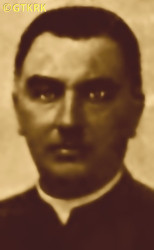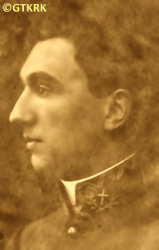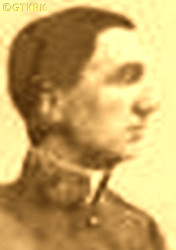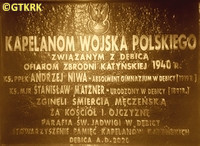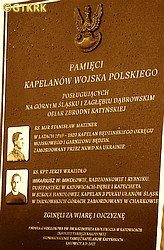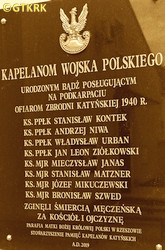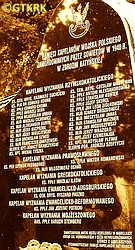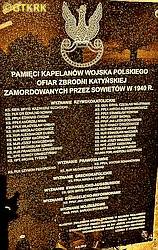Roman Catholic
St Sigismund parish
05-507 Słomczyn
85 Wiślana Str.
Konstancin deanery
Warsaw archdiocese, Poland
full list:
displayClick to display full list

searchClick to search full list by categories
wyświetlKliknij by wyświetlić pełną listę po polsku

szukajKliknij by przeszukać listę wg kategorii po polsku

Martyrology of the clergy — Poland
XX century (1914 – 1989)
personal data
surname
MATZNER
surname
versions/aliases
MACNER
forename(s)
Stanislav Clement (pl. Stanisław Klemens)
function
diocesan priest
creed
Latin (Roman Catholic) Church RCmore on
en.wikipedia.org
[access: 2014.09.21]
diocese / province
Przemyśl diocesemore on
www.przemyska.pl
[access: 2013.02.15]
RC Military Ordinariate of Polandmore on
en.wikipedia.org
[access: 2014.12.20]
honorary titles
Gold „Cross of Merit”more on
Gold „Cross of Merit”
(11.11.1937)
Ten Years of Independence Medalmore on
Ten Years of Independence Medal
Commemorative Medal for War of 1918–21more on
Commemorative Medal for War of 1918-21
„In the Penitentiary Service” Badge — goldenmore on
„In the Penitentiary Service” Badge – golden
(30.06.2017)
alt. dates and places
of death
22.10.1940, 11.1940
NKVD KievHQ at 17 Korolyenky Str.
today: 33 Volodimirska Str., Kiev city rai., Kiev city obl., Ukraine
more on
en.wikipedia.org
[access: 2023.03.02]
NKVD KharkivHQ at 5 Sovnarkomskaya Str.
today: 5 Mirronosits Str., Kharkiv urban hrom., Kharkiv rai., Kharkiv obl., Ukraine
more on
en.wikipedia.org
[access: 2022.08.05]
Khersontoday: Kherson urban hrom., Kherson rai., Kherson obl., Ukraine
more on
en.wikipedia.org
[access: 2022.08.05]
details of death
At the beginning of World War I of 1914‐1918, ministered in Gorlice. On 18.11.1914, the town was captured by the Russians. Regular robberies of property began. On 14.12.1914, the Russians withdrew, but returned again on 25.12.1914. Gorlice became a front–line town. Lines of entrenchments and trenches were built in the area. On 02.05.1915, one of the most important battles of the entire war began near Gorlice. Austro–Hungarian and German troops broke through the front line and led to a panicky escape of the Russians far to the east, to the eastern borders of the former Polish–Lithuanian Commonwealth.
After the return of the Austro–Hungarian authorities, on 01.03.1916 appointed a reserve chaplain in the Army of the Austro–Hungarian Monarchy, and then called up for active service. Served — as a district chaplain — in the south–western counties of the Germ. Militärgeneralgouvernement Lublin (Eng. General Government of Lublin) run by Austro–Hungarians. In 10.1918 was actually in Olkusz and ministerd in an endemic hospital in the neighbouring village of Starczynów — the area was hit by an epidemic of typhoid fever, brought by Ruthenians evacuated from Volyn; c. 6,000 people fell ill, 532 died.
On 01.11.1918, members of the conspiratorial Polish Military Organisation POW in Olkusz took over the Austro–Hungarian military district command in the town, and the next day disarmed the local army company, after which the administration of the district was taken over by the Poles. In the evening of that day, a unit of the rebellious 1st Uhlan Regiment — nominally still part of the Austro–Hungarian Army, but already expressing readiness to join the Polish Army — entered the town. This happened c. 10 days before 11.11.1918, the day of the end of World War I and the rebirth of the Polish state — on that day, in a staff carriage in Compiègne, at the headquarters of French Marshal Ferdinand Foch, an armistice between the Allies and the Germans was signed; on the same day, the Regency Council established by the Germans, operating in the so‐called Germ. Kaiserlich–deutsche Generalgouvernement Warschau (Eng. Imperial–German General Governorate of Warsaw) occupied by the Germans, transferred supreme authority over the army to Brigadier Joseph Piłsudski and appointed him commander‐in‐chief of the Polish army, which de facto meant the rebirth of the Polish state.
At that time, joined the nascent Polish Army. While serving in the hospital in Starczynów, contracted typhoid fever and had to undergo convalescence. After its completion, became a commissioned chaplain of the Polish Army.
After the German invasion of the Republic of Poland on 01.09.1939 (the Russians attacked Poland 17 days later) and the beginning of World War II, got evacuated to Lviv.
There, survived the siege of that city, its capitulation to the Russians on 22.09.1939 and the beginning of the Russian occupation.
From then on, was in hiding.
In late 1939 or early 1940, was arrested by the Russians.
Imprisoned in Lviv.
Further fate unknown — by the Russians as part of the mass murder known as the «Katyn genocide».
His name is on the so‐called «Tsvetukhin's list», i.e. a report that was sent from Kiev to the 1st Special Department of the NKVD in Moscow on 25.11.1940 — one of the available lists of Poles genocidally murdered by the NKVD (known also as «Ukrainian Katyn List»). The report contains 3,435 names of people killed on the basis of one of 33 „disposition lists” — lists sent from the NKVD headquarters, based on the decisions of the Special NKVD College, i.e. the genocidal kangaroo court known as the «NKVD Troika», to the local NKVD center responsible for executions. The said report states that his name — at No. 1907 — was on the „disposition list” No. 55/4 item 32 (though such „disposition list” has not been found).
None of the people on this „disposition list” were found — they were all murdered by the Russians.
On 22.07.2022, by the decision of the Polish Minister of National Defense posthumously promoted to the rank of lieutenant colonel.
cause of death
mass murder
perpetrators
Russians
sites and events
NKVD UkraineClick to display the description, NKVD KharkivClick to display the description, «Katyn genocide 1940»Click to display the description, Kiev (Lyukyanivska)Click to display the description, Ribbentrop‐MolotovClick to display the description, Pius XI's encyclicalsClick to display the description, Polish‐Russian war of 1919‐1921Click to display the description
date and place
of birth
07.03.1891Birth certification on:
photos.szukajwarchiwach.gov.pl
[access: 2025.03.18]

Kawęczyntoday: part of the Kawęczyn–Pana Tadeusza Housing Estate in Dębica, Dębica urban gm., Skuodas pov., Subcarpathia voiv., Poland
more on
en.wikipedia.org
[access: 2021.06.07]
parents
MATZNER Clement
🞲 ?, ? — 🕆 ?, ?

ORŁOWSKA Emily
🞲 ?, ? — 🕆 ?, ?
baptism
31.03.1891Birth certification on:
photos.szukajwarchiwach.gov.pl
[access: 2025.03.18]

Dębicatoday: Dębica urban gm., Dębica pov., Subcarpathia voiv., Poland
more on
en.wikipedia.org
[access: 2021.06.07]
St Hedwig of Silesia and St Margaret the Virgin and Martyr RC church
presbyter (holy orders)
ordination
13.07.1913

positions held
1939
RC senior military chaplain — Warsawtoday: Warsaw city pov., Masovia voiv., Poland
more on
en.wikipedia.org
[access: 2021.10.09] ⋄ Corps District OK No. I Warsaw, Polish Armed Forces ⋄ St George the Martyr RC military parish — also: administrator of the military parish
1931 – 1939
RC senior military chaplain — Lvivtoday: Lviv urban hrom., Lviv rai., Lviv obl., Ukraine
more on
en.wikipedia.org
[access: 2022.01.16] ⋄ Corps District OK No. VI Lviv, Polish Armed Forces ⋄ Blessed Virgin Mary Queen of Poland RC military parish — head of the pastoral region covering the garrisons of the Polish Armed Forces in Lviv, Zhovkva, Rava–Ruska, Sokal, Kamyanka Strumilova, Radekhiv, Brody, Bibrka, Jagiellonian Horodok; also: pastor of the military parish
01.01.1936
RC senior military chaplain — Polish Armed Forces — promotion: in the rank of major
03.10.1927 – 1931
RC military chaplain — Brest on Bugform.: Brest‐Litovsk /till 1923/
today: Brest, Brest dist., Brest reg., Belarus
more on
en.wikipedia.org
[access: 2021.09.29] ⋄ Corps District OK No. IX Brest on Bug, Polish Armed Forces ⋄ St Casimir RC military parish — acting head of the pastoral region; also: pastor of the military parish
24.08.1922 – 03.10.1927
RC military chaplain — Stanislavivtoday: Ivano‐Frankivsk, Stanislaviv/Ivano‐Frankivsk rai., Stanislaviv/Ivano‐Frankivsk obl., Ukraine
more on
en.wikipedia.org
[access: 2020.11.20] ⋄ prison, Command of the Corps District DOK No. VI Lviv, Polish Armed Forces
03.1922 – 24.08.1922
RC military chaplain — Lvivtoday: Lviv urban hrom., Lviv rai., Lviv obl., Ukraine
more on
en.wikipedia.org
[access: 2022.01.16] ⋄ House of War Invalids, Corps District OK No. VI Lviv, Polish Armed Forces — commissioned; by decree of the Chief of State of ‐03.05.1922, confirmed with seniority from 01.06.1919 and 26th place on the list of Roman Catholic military chaplains, in the rank of captain; by decree No. L. 3448 of the Commander‐in‐Chief of 16.12.1921, verified with seniority from 01.04.1920 and 25th place on the list of Roman Catholic military chaplains, in the rank of captain
15.11.1921 – 03.1922
RC military chaplain — Kielcetoday: Kielce city pov., Holy Cross voiv., Poland
more on
en.wikipedia.org
[access: 2021.06.07] ⋄ garrison, Command of the Corps District DOK No. X Przemyśl, Polish Armed Forces ⋄ Ascension of the Lord RC garrison church
08.1920 – 15.11.1921
RC military chaplain — Kielcetoday: Kielce city pov., Holy Cross voiv., Poland
more on
en.wikipedia.org
[access: 2021.06.07] ⋄ Command of the General District DOG „Kielce”, Polish Armed Forces ⋄ Ascension of the Lord RC garrison church (till 1915 and the Russians escape from Polish territory (known as bezhenstvo) Orthodox church) — acting („ad interim”) military pastor
10.09.1919 – 10.08.1920
RC military chaplain — Będzintoday: Będzin pov., Silesia voiv., Poland
more on
en.wikipedia.org
[access: 2020.12.11] ⋄ garrison, General District OG „Kielce”, Polish Armed Forces
03.07.1919 – 10.09.1919
RC military chaplain — Kielcetoday: Kielce city pov., Holy Cross voiv., Poland
more on
en.wikipedia.org
[access: 2021.06.07] ⋄ Command of the General District DOG „Kielce”, Polish Armed Forces
04.01.1919 – 03.07.1919
RC military chaplain — Będzintoday: Będzin pov., Silesia voiv., Poland
more on
en.wikipedia.org
[access: 2020.12.11] ⋄ Command of the Military District DOW „Będzin”, Command of the General District DOG „Kraków”, Polish Armed Forces — also: from 03.1919 chaplain of the „Będzin” Stage District Command DOE
11.11.1918 – 04.01.1919
RC military chaplain — Olkusztoday: Olkusz gm., Olkusz pov., Lesser Poland voiv., Poland
more on
en.wikipedia.org
[access: 2021.06.07] ⋄ Polish Armed Forces — i.a. chaplain of the endemic hospital in Starczynów
1916 – 11.11.1918
chaplain — Germ. Militärgeneralgouvernement Lublin (Eng. Lublin General Governorate), Austro–Hungarian Imperial Army — district chaplain for Olkusz, Miechów, Dąbrowa, Włoszczowa and the Jasna Góra monastery in Częstochowa districts; in 10.1918 ministered, among others, in Starczynów, c. 8 km from Olkusz, in the local endemic hospital
1913 – c. 1915
vicar — Gorlicetoday: Gorlice gm., Gorlice pov., Lesser Poland voiv., Poland
more on
en.wikipedia.org
[access: 2021.04.01] ⋄ Nativity of the Blessed Virgin Mary RC parish ⋄ Biecztoday: Biecz gm., Gorlice pov., Lesser Poland voiv., Poland
more on
en.wikipedia.org
[access: 2021.04.01] RC deanery — also: prefect of elementary schools
1909 – 1913
student — Przemyśltoday: Przemyśl city pov., Subcarpathia voiv., Poland
more on
en.wikipedia.org
[access: 2021.04.01] ⋄ philosophy and theology, Theological Seminary
others related
in death
BĄCZKOWSKIClick to display biography Thaddeus, TELEŻYŃSKIClick to display biography Michael, TYSZKAClick to display biography Michael, NIEIZWIESTNYClick to display biography Anatol
sites and events
descriptions
NKVD Ukraine: In 04‐05.1940, the Russian genocidal NKVD organization shot in Ukraine — as part of the «Katyn genocide of 1940» — c. 3,435 people (according to some assumptions, there could have been even 4,181). This genocide was the implementation of the decision of the Russian Commie–Nazi authorities — the Politburo of the Russian Commie–Nazi party — of 05.03.1940 to exterminate tens of thousands of Polish intelligentsia and military personnel held in Russian camps established after the German–Russian Ribbentrop–Molotov Agreement and the annexation of half of Poland by the Russians in 1939. After the formal „verdict”, the NKVD Special Council, i.e. genocidal Russian kangaroo court known as «NKVD Troika», in Moscow sent 33 disposition letters to the NKVD in Ukraine, containing the names of people to be murdered. In order to implement it, the head of the NKVD, Lavrentiy Beria, issued on 22.03.1940 order No. 00350 on the „unloading of NKVD prisons”, ordering the transport of prisoners from Lviv, Rivne, Ternopil, Drohobych, Stanislaviv and from the „Volyn” prison to prisons in Kiev, Kharkov and Kherson. There is a known list of 3,435 personal files of executed Polish citizens — sent on 25.11.1940 by the NKVD of Ukraine to the 1st Special Department of the NKVD in Moscow (personally to Leonid Bashtakov, one of the «NKVD Troika» members) — known as the «Ukrainian Katyn List» or «Tsvetukhin's list». It contains names of 726 officers of the Polish Army (including 7 generals), 770 officers of the State Police, 28 officers of the Prison Guard. The rest are civilians. It is not known where they were murdered or where they are buried. An unknown number were held in Lyukyanivska prison in Kiev, and then murdered in the building at 17 Korolyenky Str. (today 33 Volodimirska Str.), the Ukrainian headquarters of the NKVD. The bodies were probably buried in the forest, in Bykivnya near Kiev. Some of the victims were prob. murdered in the NKVD headquarters in Kharkiv, where Polish officers from the KLW Starobilsk concentration camp were also executed. It is not known whether and where they were killed in Kherson. The victims were murdered in soundproof basements, one by one, by the so‐called Katyn method, with a pistol shot to the back of the head. (more on: pl.wikipedia.orgClick to attempt to display webpage
[access: 2013.08.10], pl.wikipedia.orgClick to attempt to display webpage
[access: 2013.08.10])
NKVD Kharkiv: On 05.04‐12.05.1940 Russians executed in NKVD headquarters at 5 Sovnarkomskaya Str. (today 5 Mirronosits Str.) in Kharkiv c. 3,739 Polish prisoners of war (POW) kept in KLW Starobilsk concentration camp in Starobilsk. This genocide was the implementation of the decision of the Russian Commie‐Nazi authorities — the Politburo of the Russian Commie‐Nazi party — of 05.03.1940 to exterminate tens of thousands of Polish intelligentsia and servicemen, held in Russian camps established after the German‐Russian Ribbentrop‐Molotov Agreement and the annexation of half of Poland by the Russians in 1939, known as «Katyn genocide». After the formal „verdict”, the NKVD Special Council Moscow, i.e. the genocidal Russian kangaroo court known as the «NKVD Troika», sent successive disposition letters to the NKVD in Kharkiv — there were c. 36 of them — containing the names of the persons to be murdered. The murders were committed in the NKVD District Directorate HQ, at 3 Dzerzhinsky Sq. Convoys of prisoners were transported by rail to the Kharkov railway station, and from there by car to the NKVD headquarters. The victims' hands were tied behind their backs with a rope and at night they were taken to a windowless room in the basement. There, they were murdered with a shot in the neck from a 7.62 mm Nagant revolver. Immediately afterwards, the bodies were taken away in trucks and buried in mass graves near Kharkov, 1.5 km from the village of Piatykhatky. Prob. also later, till 06.1940, an unknown number of Poles from the so–called «Ukrainian Katyn List» or «Tsvetukhin's list» were murdered there in the same way. (more on: en.wikipedia.orgClick to attempt to display webpage
[access: 2014.09.21])
«Katyn genocide 1940»: 05.03.1940, the Russian Commie‐Nazi authorities — the Politburo of the Russian Commie‐Nazi party headed by Joseph Stalin — made a formal, secret decision No. P13/144 to exterminate tens of thousands of Polish intelligentsia and military personnel, „declared and hopeless enemies of the Russian government”, held in Russian camps, as a consequence of the German‐Russian Ribbentrop‐Molotov Agreement, the invasion of Poland and annexation of half of Poland in 09.1939, and the beginning of World War II. The decision was, as it were, „sanctioned” by the verdicts of the NKVD Special Council, i.e. the genocidal Russian kangaroo court known as «NKVD Troika» in Moscow. The implementation in Ukraine and Belarus was made possible by order No. 00350 of 22.03.1940 of the head of the NKVD, Lavrentiy Beria, on the „unloading of NKVD prisons”, i.e. transfer of prisoners from several prisons in Ukraine and Belarus to central prisons, e.g. in Kiev or Minsk. The genocidal «NKVD Troika», after issuing sentences, also sent to local NKVD units, NKVD disposition lists — i.e. lists of convicts — each containing on average c. 100 names. Named lists are known — may be reconstructed — for people held in the KLW Kozelsk and KLW Ostashkov camps, but not for KLW Starobilsk, known for victims from Ukrainian prisons, but not Belarusian ones. It is not even known exactly how many lists there were, mainly because the number of them sent to the NKVD in Belarus is unknown. On 03.03.1959 Alexander Shelepin, then head of the Russian KGB, in a handwritten note stated: „ Since 1940, the Committee for State Security under the Council of Ministers of Russia, has been keeping records and other materials relating to the prisoners of war and interned officers, gendarmes, policemen, etc., people from former bourgeois Poland shot that year. In total, based on the decision of the special troika of the NKVD of the USSR, 21,857 people were shot, of whom: 4,421 people in the Katyn Forest (Smolensk Oblast), 3,820 people from the Starobilsk camp near Kharkov, 6,311 people from the Ostashkov camp (Kalinin Oblast), and 7,305 people in other camps and prisons in Western Ukraine and Western Belarus. The entire operation of liquidation of the above–mentioned was carried out on the basis of the Resolution of the Central Committee of the CPSU of 05.03.1940”. The head of the NKVD recommended to the Russian leader, Nikita Khrushchev, to destroy all personal files of those shot in 1940, but to keep the minutes of the meetings of the «NKVD Troika» and confirmations of the implementation of the decisions of the «NKVD Troika». A one–sentence draft resolution was attached to the note. It is not known whether the resolution was accepted and whether the files were destroyed. The aforementioned protocols and confirmations of the «NKVD Troika» are also not known. There are indications — i.e. four so‐called „NKVD‐Gestapo Methodical Conferences” of 1939‐1940: in Brest on Bug, Przemyśl, Zakopane and Cracow — of close collaboration between Germans and Russians in realization of plans of total extermination of Polish nation, its elites in particular — decision that prob. was confirmed during meeting of socialist leaders of Germany: Mr Heinrich Himmler, and Russia: Mr Lavrentyi Beria, in another German leader, Mr Hermann Göring, hunting lodge in Rominty in Romincka Forest in East Prussia. (more on: en.wikipedia.orgClick to attempt to display webpage
[access: 2023.12.15])
Kiev (Lyukyanivska): Russian political prison in Kiev, in the first half of 20th century run by the genocidal NKVD, informally referred to as prison No 1, formally as Investigative Prison No 13 (SIZO#13). It was founded in the early 19th century. In the 20th century, during the Soviet times, the prison church was transformed into another block of cells. During the reign of J. Stalin in Russia, more than 25,000 prisoners passed through it. (more on: en.wikipedia.orgClick to attempt to display webpage
[access: 2014.09.21])
Ribbentrop‐Molotov: Genocidal Russian‐German alliance pact between Russian leader Joseph Stalin and German leader Adolf Hitler signed on 23.08.1939 in Moscow by respective foreign ministers, Mr. Vyacheslav Molotov for Russia and Joachim von Ribbentrop for Germany. The pact sanctioned and was the direct cause of joint Russian and German invasion of Poland and the outbreak of the World War II in 09.1939. In a political sense, the pact was an attempt to restore the status quo ante before 1914, with one exception, namely the „commercial” exchange of the so‐called „Kingdom of Poland”, which in 1914 was part of the Russian Empire, fore Eastern Galicia (today's western Ukraine), in 1914 belonging to the Austro‐Hungarian Empire. Galicia, including Lviv, was to be taken over by the Russians, the „Kingdom of Poland” — under the name of the General Governorate — Germany. The resultant „war was one of the greatest calamities and dramas of humanity in history, for two atheistic and anti‐Christian ideologies — national and international socialism — rejected God and His fifth Decalogue commandment: Thou shall not kill!” (Abp Stanislav Gądecki, 01.09.2019). The decisions taken — backed up by the betrayal of the formal allies of Poland, France and Germany, which on 12.09.1939, at a joint conference in Abbeville, decided not to provide aid to attacked Poland and not to take military action against Germany (a clear breach of treaty obligations with Poland) — were on 28.09.1939 slightly altered and made more precise when a treaty on „German‐Russian boundaries and friendship” was agreed by the same murderous signatories. One of its findings was establishment of spheres of influence in Central and Eastern Europe and in consequence IV partition of Poland. In one of its secret annexes agreed, that: „the Signatories will not tolerate on its respective territories any Polish propaganda that affects the territory of the other Side. On their respective territories they will suppress all such propaganda and inform each other of the measures taken to accomplish it”. The agreements resulted in a series of meeting between two genocidal organization representing both sides — German Gestapo and Russian NKVD when coordination of efforts to exterminate Polish intelligentsia and Polish leading classes (in Germany called «Intelligenzaktion», in Russia took the form of Katyń massacres) where discussed. Resulted in deaths of hundreds of thousands of Polish intelligentsia, including thousands of priests presented here, and tens of millions of ordinary people,. The results of this Russian‐German pact lasted till 1989 and are still in evidence even today. (more on: en.wikipedia.orgClick to attempt to display webpage
[access: 2015.09.30])
Pius XI's encyclicals: Facing the creation of two totalitarian systems in Europe, which seemed to compete with each other, though there were more similarities than contradictions between them, Pope Pius XI issued in 03.1937 (within 5 days) two encyclicals. In the „Mit brennender Sorge” (Eng. „With Burning Concern”) published on 14.03.1938, condemned the national socialism prevailing in Germany. The Pope wrote: „Whoever, following the old Germanic‐pre‐Christian beliefs, puts various impersonal fate in the place of a personal God, denies the wisdom of God and Providence […], whoever exalts earthly values: race or nation, or state, or state system, representatives of state power or other fundamental values of human society, […] and makes them the highest standard of all values, including religious ones, and idolizes them, this one […] is far from true faith in God and from a worldview corresponding to such faith”. On 19.03.1937, published „Divini Redemptoris” (Eng. „Divine Redeemer”), in which criticized Russian communism, dialectical materialism and the class struggle theory. The Pope wrote: „Communism deprives man of freedom, and therefore the spiritual basis of all life norms. It deprives the human person of all his dignity and any moral support with which he could resist the onslaught of blind passions […] This is the new gospel that Bolshevik and godless communism preaches as a message of salvation and redemption of humanity”… Pius XI demanded that the established human law be subjected to the natural law of God , recommended the implementation of the ideal of a Christian state and society, and called on Catholics to resist. Two years later, National Socialist Germany and Communist Russia came together and started World War II. (more on: www.vatican.vaClick to attempt to display webpage
[access: 2023.05.28], www.vatican.vaClick to attempt to display webpage
[access: 2023.05.28])
Polish‐Russian war of 1919‐1921: War for independence of Poland and its borders. Poland regained independence in 1918 but had to fight for its borders with former imperial powers, in particular Russia. Russia planned to incite Bolshevik‐like revolutions in the Western Europe and thus invaded Poland. Russian invaders were defeated in 08.1920 in a battle called Warsaw battle („Vistula river miracle”, one of the 10 most important battles in history, according to some historians). Thanks to this victory Poland recaptured part of the lands lost during partitions of Poland in XVIII century, and Europe was saved from the genocidal Communism. (more on: en.wikipedia.orgClick to attempt to display webpage
[access: 2014.12.20])
sources
personal:
episkopat.plClick to attempt to display webpage
[access: 2019.10.13], docplayer.plClick to attempt to display webpage
[access: 2019.10.13], archiwum-ordynariat.wp.mil.plClick to attempt to display webpage
[access: 2025.08.19], photos.szukajwarchiwach.gov.plClick to attempt to display webpage
[access: 2025.03.18], wcrwarszawa-srodmiescie.wp.mil.plClick to attempt to display webpage
[access: 2025.08.19]
bibliographical:
„Schematismus Venerabilis Cleri Dioecesis PremisliensisClick to display source page”, Przemyśl diocesa Curia, from 1866 to 1938
original images:
commons.wikimedia.orgClick to attempt to display webpage
[access: 2019.10.13], forum.odkrywca.plClick to attempt to display webpage
[access: 2023.12.10], ordynariat.wp.mil.plClick to attempt to display webpage
[access: 2022.05.23], parafia-wojskowa-radom.plClick to attempt to display webpage
[access: 2023.12.10], ordynariat.wp.mil.plClick to attempt to display webpage
[access: 2022.05.23], pamietajskadjestes.plClick to attempt to display webpage
[access: 2023.12.10], radio.lublin.plClick to attempt to display webpage
[access: 2022.05.23], ofm.krakow.plClick to attempt to display webpage
[access: 2022.05.23]
LETTER to CUSTODIAN/ADMINISTRATOR
If you have an Email client on your communicator/computer — such as Mozilla Thunderbird, Windows Mail or Microsoft Outlook, described at WikipediaPatrz:
en.wikipedia.org, among others — try the link below, please:
LETTER to CUSTODIAN/ADMINISTRATORClick and try to call your own Email client
If however you do not run such a client or the above link is not active please send an email to the Custodian/Administrator using your account — in your customary email/correspondence engine — at the following address:

giving the following as the subject:
MARTYROLOGY: MATZNER Stanislav Clement
To return to the biography press below:
 Click to return to biography
Click to return to biography








